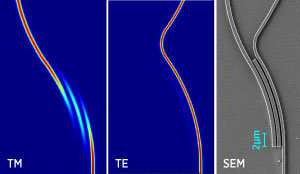Triple bend structure splits light into two highly pure polarization components

A plan to incorporate a third bent waveguide into a silicon-based light splitter led A*STAR researchers to develop a device capable of a 30-fold improvement in splitting efficiency. The novel on-chip light splitter marks a major breakthrough in improving high-performance data transmission systems, as well as applications in quantum computing.
The manipulation of light in micro-scale devices is a fundamental pillar of high-speed optical circuits underpinning communications and next-generation technologies like quantum computing. Light is fast and low-power, and can be encoded to transmit data in a variety of ways. As Thomas Ang from the A*STAR Institute of High Performance Computing (IHPC) explains, for these manipulations to be reliable and efficient, the light needs to be as 'pure' as possible—not just tightly confined around a specific wavelength, but also of a uniform polarization.
"Light consists of a mixture of two polarization components," Ang says. "Polarization beam splitters are used to separate a mixed-polarization beam into two channels for each polarization."
When the splitting is imperfect, the two channels can contain small proportions of the opposite polarization, an effect known as crosstalk.
"Polarization beam splitters with low crosstalk are very important for high signal fidelity in high-speed optical interconnect applications," says Jun Rong Ong, Ang's partner in the study. "Current technology is limited to a crosstalk level, called the extinction ratio, of around 25 decibels, which is high enough to affect high-speed data transmission."
The field of polarization beam splitters (PBSs) is well-developed, and there have been many attempts to break this 25 decibel limit in silicon-based devices as the industry standard for fabrication. Ang, Ong and their colleagues brainstormed ways to challenge this limit, and came up with the idea of adding a third waveguide—essentially a channel or path to route light on a chip—when the status quo dictated no more than two.
"We were interested in waveguides for bending and routing light, and conceptualized our new design after brainstorming within our team," says Ang. "We tested our hypothesis using computer simulations and were thrilled to find that the device outperformed some of the best-in-class published results."
Working with collaborators at the Singapore University of Technology and Design, the team then fabricated the three-waveguide device (see image) and confirmed its vastly improved extinction ratio of 40 decibel, representing a further 30-fold reduction in polarization crosstalk.
"We also expect that the device can be improved further by optimizing its design," says Ong.
More information: Jun Rong Ong et al. Broadband silicon polarization beam splitter with a high extinction ratio using a triple-bent-waveguide directional coupler, Optics Letters (2017). DOI: 10.1364/OL.42.004450
Journal information: Optics Letters





















